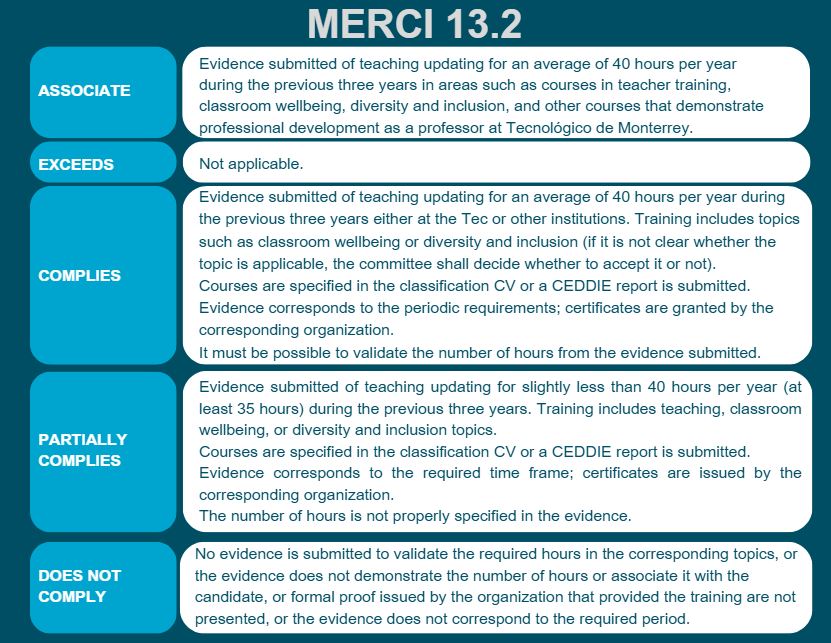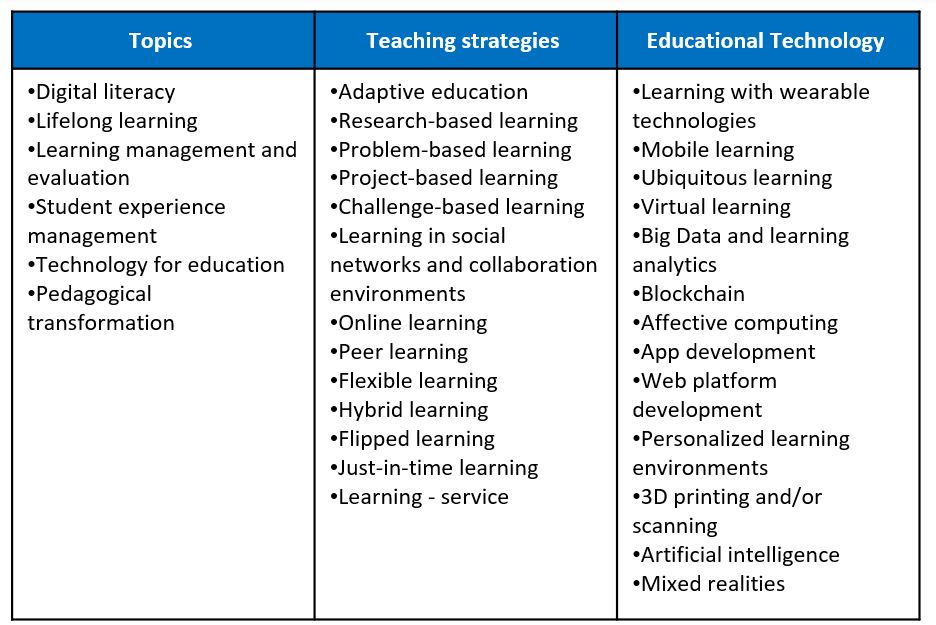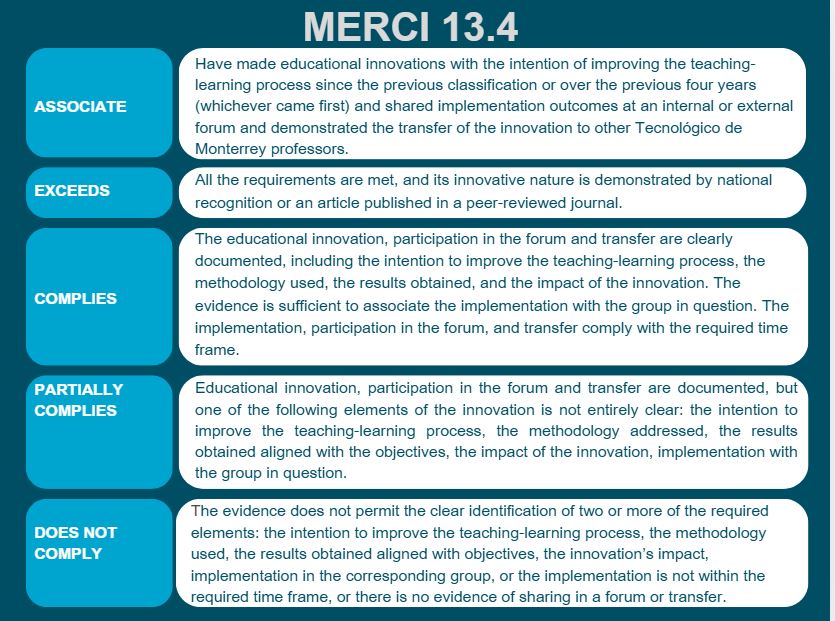- ARTICLE 13.1
-
13.1 Having scored a weighted average of 9.0 in the Student Survey (ECOA) over the previous three years. In the event of the weighted average being as low as 8.5, complementary evidence of teaching methods may be submitted.
Description
The Student Opinion Survey (Spanish acronym: ECOA) is an instrument that captures students’ collective opinion of a course and the professor. Its results provide relevant information and can help professors recognize strengths and areas of opportunity to improve their teaching and interaction with students.
The annual weighted average of the ECOA is added to the professor’s classification CV. Weighting is done based on the number of students involved:
- The evaluation obtained from each course is multiplied by the number of students on the course.
- All the multiplication results are added together.
- The number of students who took all courses is calculated.
- The total obtained in point 2 is divided by the total obtained in point 3.
As of the 2024-2025 call, a single comprehensive ECOA calculation is performed for the previous three years. EVAp [Spanish acronym: Overall, my learning experience with the teacher was...] is considered for courses taught following the 2019 syllabus in the evaluation; the REC indicator [Spanish acronym: Would you recommend a friend to take classes with this teacher?] is contemplated for ECOAs concerning course plans prior to 2019.
The Associate category requires a weighted average of 9.0 or higher. In the event of the weighted three-year average being at least 8.5, supplementary evidence may be submitted providing relevant information about your teaching practice. The following are examples of this:
a) A letter containing net positive mentions in ECAG in at least three of the previous six semesters. This letter may be obtained at ECOA&ECAG&ProfInspira › ECOA.
Each person must use their institutional credentials to review the information (the net number is calculated to be the difference between the number of “best teacher” minus the number of “worst teacher” mentions).
b) Justification letter (with supporting evidence) in the event of there being any particular special circumstance that has had a negative impact on ECOA evaluations.
Reflective essay on teaching methods, explaining improvements that have been made (with supporting evidence). You can review aspects to be considered when writing the essay here.
Reference
Format 13.1
Evaluation

Example
Example 13.1
- ARTICLE 13.2
-
13.2 Evidence submitted of teaching updating for an average of 40 hours per year during the previous three years in areas such as courses in teacher training, classroom wellbeing, diversity and inclusion, and other courses that demonstrate professional development as a professor at Tecnológico de Monterrey.
Description
Our institution considers it essential to help teachers achieve teaching excellence; consequently, we expect an ongoing commitment from each and every one of them to develop their skills, knowledge, and enrich their teaching practice all the while seeking to successfully implement the various elements of the institution’s educational model. The institution offers a range of training, mentoring programs, workshops, and development experiences, all available to help Tecnológico de Monterrey faculty members flourish as they grow in the institution. The development model and courses offered can be consulted at https://ceddie.tec.mx/.
Currently, there is a need for constant development of teaching skills such as course and lesson planning, sharing or implementation of learning experiences, educational assessment, and other areas related to the wellbeing of teachers and students. It is important to ensure that all teachers have the support and preparation to deal constructively with challenges that may arise in the classroom.
Ongoing development and strengthening of teaching competencies enables teachers to contribute to their students’ success, optimize learning outcomes within the framework of our educational model, and make use of the vast institutional learning resources available to them.
Required evidence may be an entry in the classification CV or take the form of the CEDDIE training Kardex or other training certificates issued by relevant educational institutions (e.g. Coursera Certificate in Pedagogy, Google Educator Certificate, etc.).
External evidence must be provided by a third party; in this case, the institution, association or organization that provided the training. Care should be taken that dates and classification periods coincide and that the submitted evidence specifies the number of hours dedicated and briefly contextualizes the content, noting how it is related to teacher development, classroom wellbeing, diversity and inclusion, in addition to other courses that evidence professional development (inspirational, innovative, up-to-date in the discipline, linked to the environment, and user of technology in teaching practice) as a professor at Tecnológico de Monterrey.
Occasionally, certificates may not specify the official length of the course in hours. In these cases, arguments may be given, supported, for example, by the course syllabus or a MOOC screenshot describing the course and specifying its length in hours.
Evidence of an average total of 40 hours per year over the previous three years must be provided, i.e., evidence of at least 120 total hours over the three-year period. A table may be added summarizing courses and hours (indicating that these are documented in SSFF, in the classification CV, or if they are external certificates).
It is important to point out that evidence of professional discipline updating on different topics can be found in another article pertaining to intellectual vitality.
Reference
Format 13.2
Evaluación

Example
Example 13.2
- ARTICLE 13.3
-
13.3 In the past 4 years, integrate digital education tools in classes to facilitate the teaching-learning process, submit evidence of at least two such integrations in courses, and demonstrate transfer to at least one other Tecnológico de Monterrey professor.
Description
Digital education in the Tecnológico de Monterrey educational model seeks to enrich students’ learning experiences through an educational ecosystem involving the use of innovative teaching methods and digital educational tools.
Digital education tools or tools for digital education are applications or software that run on computers or electronic devices, may or may not connect to the internet, and are used for educational purposes. They enable teachers to offer their students an enriched, flexible, interactive, and/or tailor-made educational experience. Professors are expected to integrate these tools into their teaching to facilitate certain aspects of teaching or student learning.
Compliance with this criterion is demonstrated with evidence of two of these tools being used in one of their courses.
Integrating digital tools to facilitate the learning-teaching process is necessary in today’s changing and digitized world. Today’s students are not very attracted to traditional learning models in which professors lecture and students listen, take notes and review the textbook, trying to memorize, process and later verify through repetition. Currently, a single course may integrate different digital tools to support and facilitate learning. There are digital tools for giving presentations, setting up active discussions, collaborating, reviewing, studying, giving feedback, practicing, and evaluating (among others). In the modern context, professors have to select the best tools for their classes skillfully and integrate them into an educational package that appeals to their students’ different learning styles. Professors are expected to implement this kind of integration on a regular basis, semester by semester, in all of their subjects, but the submission of two integrations is required: either an illustration or an example. Additionally, at least one of the integrations is required to have been transferred to teaching colleagues at the institution.
The evidence to be submitted pursuant to this article should document complete integration in three sections: planning, execution, and evaluation of a digital education tool’s integration. The addition of these three sections demonstrates that the integration was purposeful and completed and that the ongoing improvement cycle was closed. In addition, the evidence should clearly specify the group in question and during which period the integration took place. Two such integrations are requested; consequently, the same tool may be used in two groups in different semesters, or evidence of two different integrations in different training units (TU) may be submitted. It is important to emphasize that tools should favor the learning of course-related topics and not just be used for social interaction (greeting, asking where the class will be, sharing an anecdote, etc.). Tool integration in other courses can be submitted as evidence of transfer if accompanied by a letter from the professors in charge. Evidence of having shared the integration in forums with other institution professors may also be submitted.
The main evidence required pursuant to this article involves the integrations made by professors in their courses. Consequently, the evidence must be preponderantly generated on the whole by the candidate professor and include evidence of transfer, which may be generated by third parties. It is important to note that evidence of transfer must demonstrate that the tools have been integrated by at least two other professors in their own courses (not just having shared the tool with other professors). Letters from professors and pictures of the integration done in their courses shall suffice for this purpose. It should be noted that a letter from a UF manager can help by providing evidence concerning the group, period and subject, but it should not be the main evidence.
It is important to consider that “technological tools” were required in the 2016 regulations, so the integration of analog devices was allowed. The 2023 regulations have focused the requirement on digital education tools.
Examples of digital educational tools
- Use of discipline-specific software (Autocad, Flexim, etc.) in one or more course topics to favor the development of graduation competencies.
- Use of general tools (Socrative, Kahoot, Mentimeter, TEAMs, Canva, etc.) that facilitate the teaching and learning process by becoming fully integrated in the activity.
- Digital tools facilitate teaching and learning in face-to-face or remote sessions and manifest how session participants interact; for example, conduct surveys to check learning, connect by Zoom with students from other groups and create rooms for teamwork to solve cases, problems and challenges, or use the white board to develop an activity where students collaborate, thereby favoring interaction involving the session’s contents.
Solid evidence of having integrated digital education tools to facilitate the teaching-learning process must include documentation of their implementation by showing the planning, execution, and evaluation of integrations in courses taught in the requested period. Approval of the evidence requires that implementation dates correspond to the period being evaluated.
Planning can be evidenced with a pre-prepared design (with mentoring from CEDDIE for example) or any other course-planning document demonstrating how the integration was planned. You may also include screenshots of course elements in Canvas where you can view tool planning and integration.
Implementation can be evidenced by labeled photographs, video recordings of (a) learner(s) interacting with the tool, or a copy of a learner’s submission where it is clear that the tool is being used in the learning process. If photographs are used, dates should be provided to relate them to a specific course; even so, the photograph alone does not usually provide conclusive evidence unless the course, the date, and the context are obvious.
It is important to keep in mind that video formats are not accepted as evidence on the classification platform, but it is possible to save screenshots of the video in question and then reference the video from which the screenshot was taken (with the link to the video location).
There are tools specifically designed for the teaching-learning process (e.g. software to practice solving math problems) that would be useful pursuant to this article. Many digital tools may be used in any discipline. However, it is worth mentioning that the use of specialized disciplinary software does not automatically demonstrate its integration in the teaching-learning (TL) process. How the software is being used for the (TL) process must be demonstrated: not just that the students know how to use it.
The evaluation expects evidence to show the considerations given to how each specific tool was used and/or that there is feedback available from students on its use. A formal evaluation of use can also be evidenced by published outcomes, proof of presentation in a forum, or by a document from an internal or external third party that reports, certifies, or gives awards for tool integrations.
Tools
CEDDIE
https://ceddie.tec.mx/es/innovacion-y-tecnologia-educativa
CEDDIE offers advice, tutorials and workshops on digital tool implementation in teaching and learning; it also offers support such as “CEDDIE te pone la App” (CEDDIE gives you the App) and other software license and application access schemes.
EDuTools
https://edutools.tec.mx/es/colecciones
A space where recommendations and descriptions of digital education tool use are provided.
Reference
Format 13.3
Evaluation

Example
Example 13.3
- ARTICLE 13.4
-
13.4 Participate in educational innovation with the aim of enhancing the teaching-learning process, as of their last classification or in the past four years (whichever comes first, retrospectively), sharing the results of an implementation in an internal or external forum and demonstrating the transfer of the innovation to other Tec professors.
Descripción
Our institution is committed to promoting a culture of experimentation and conscious educational entrepreneurship through an ecosystem of educational innovation that enables professors to reinvent their teaching practice and give added value to their students’ learning processes. Professors are expected to constantly refresh their teaching practice with experimentation and by integrating technological tools through techno-pedagogical decision-making for an innovative classroom experience, by transforming the teaching-learning process with methodologies focused on educational innovation, and by developing original and innovative proposals of high educational value.
Pursuant to this article, submissions should contain the following clear evidence:
- the intention to improve the teaching-learning process,
- general and particular educational innovation goals (specific and measurable),
- the methodology used to conduct the innovation project
- evidence of implementation
- education innovation results aligned with innovation goals, and
- course impact assessment.
- Proof of having participated in an institutional or external forum.
- Proof of having transferred the innovation to other professors at the Tec.
Professors are expected to integrate an educational innovation activity or a project in which it is apparent that an objective was set to improve a certain aspect of their teaching or their students’ learning process, that its development was methodological, and that a results analysis and impact description were done with regard to the established objectives. Furthermore, evidence must be submitted of having presented the innovation at an institutional or external forum and that the innovation has been transferred to other professors in the institution. It is important to point out evidence of transfer requires the innovation to have been implemented by at least two other teachers in their own courses (not only having shared the educational innovation with other teachers). Letters from professors and pictures of the integration done in their courses shall suffice for this purpose.
The documentation begins with an explicit definition of the objectives of the educational innovation in a way that allows the results of the innovation to be associated with the fulfillment of the course’s education objectives.
Evidence submitted of participation in a forum where the innovation was presented may take the form of the certificate awarded for said participation. A forum is considered to be a presentation given in an exchange of experiences session or a workshop on how to implement the innovation, an exhibition, a conference, or a publication. Evidence of transfer may be submitted, for example, by documenting at least two cases of other Tec professors integrating the innovation. Evidence of transfer may be submitted, for example, by documenting at least two cases of other Tec professors integrating the innovation, or by submitting proof of having taught a workshop concerning how to implement the innovation, etc.
Educational innovation results may be manifested as learning. There is not always a positive impact on the first attempt or iteration.
Examples of educational innovation goals
- Design a new way of addressing given course content (for example, by using a different methodology or integrating technological tools), evaluating the results obtained before and after implementation, and assessing the impact.
- The evidence must demonstrate that the professor set forth an educational objective and conducted an analysis and evaluation of results, which must be aligned with the stated objective.
Create a space in the metaverse (Virtual Campus) where two class topics may be tackled in real-world contexts. Here, problem-solving activities will enable professors to observe student competence and give them more immediate, meaningful feedback.
Examples of topics, teaching strategies and educational technology

Guiding questions
- What audience is targeted by the intervention or project?
- What is the problem to be solved or the educational process or aspect to be improved for the target audience?
- What specific goals does the educational innovation seek in terms of specific, measurable outcomes?
- How is it demonstrated that the expected impact was achieved? Are these results directly related to the goal or the problem posed?
- In what way is the proposed intervention or project considered truly innovative
The following support tools are suggested for better evidence documentation:
Support tools
My Educational Innovation
Support tool to generate evidence of Educational Innovation available at MiTEc and:
https://innovation.tec.mx/
iRegister provides support for the documentation of Educational Innovation. It has a guided format and the support of expert advisors in Educational Innovation. When the education innovation project is documented, feedback will be received from an expert, who will provide guidance on how to build up the evidence required herein.
Novus facilitates the obtention of resources to support education innovation projects.
https://novus.tec.mx/es
IFE Conference
Formerly known as CIIE, this is a space for sharing experiences, projects and research results related to educational innovation. This forum is one way of transferring educational innovations.
https://ciie.itesm.mx/es/
CEDDIE
https://ceddie.tec.mx/es/innovacion-y-tecnologia-educativa
CEDDIE offers consulting services concerning how to select methodologies for outcome follow-up and documentation; demos, workshops and consulting services to learn about teaching strategies, in addition to educational and emerging technologies.
Reference
Format 13.4
Evaluation

Example
Example 13.4